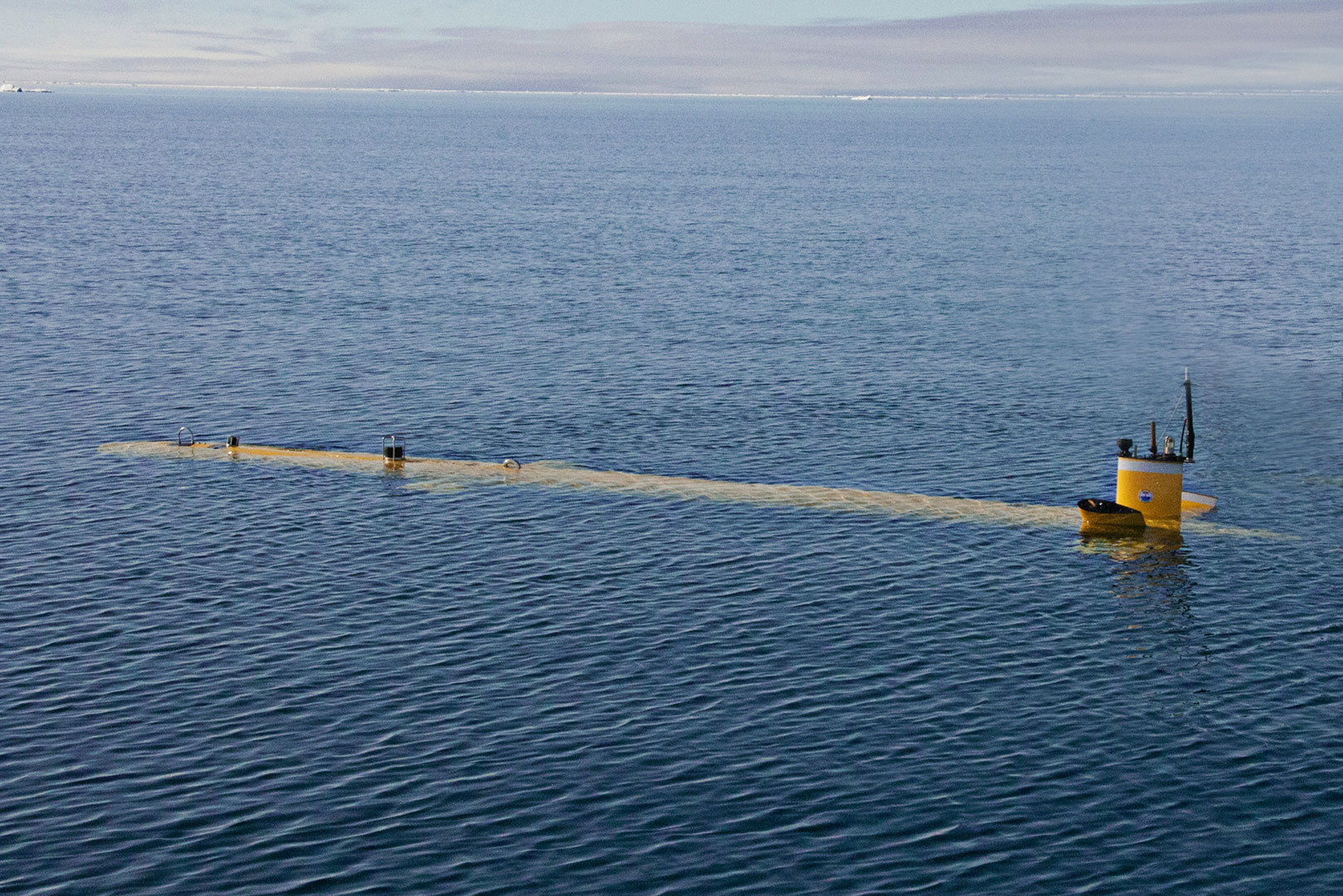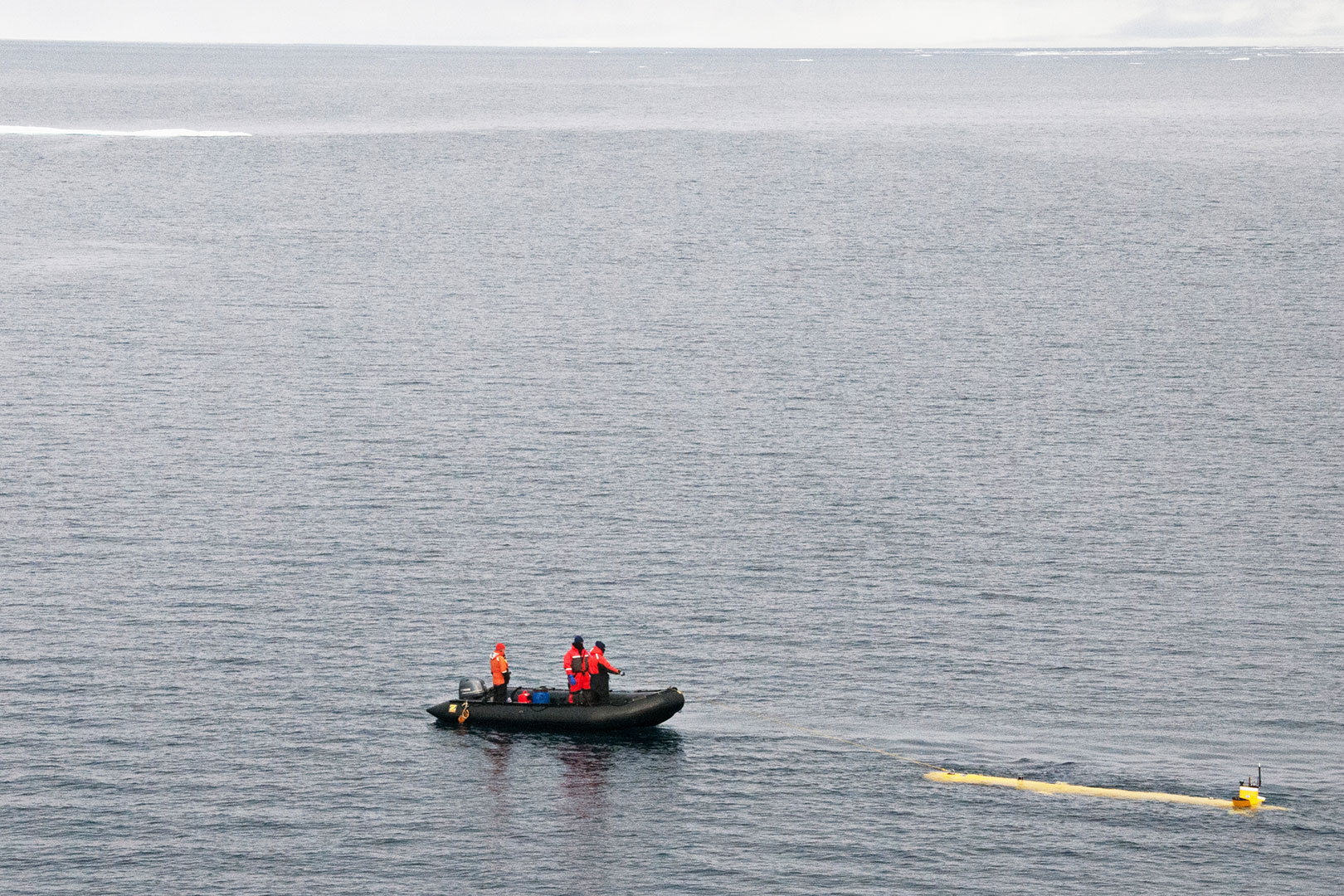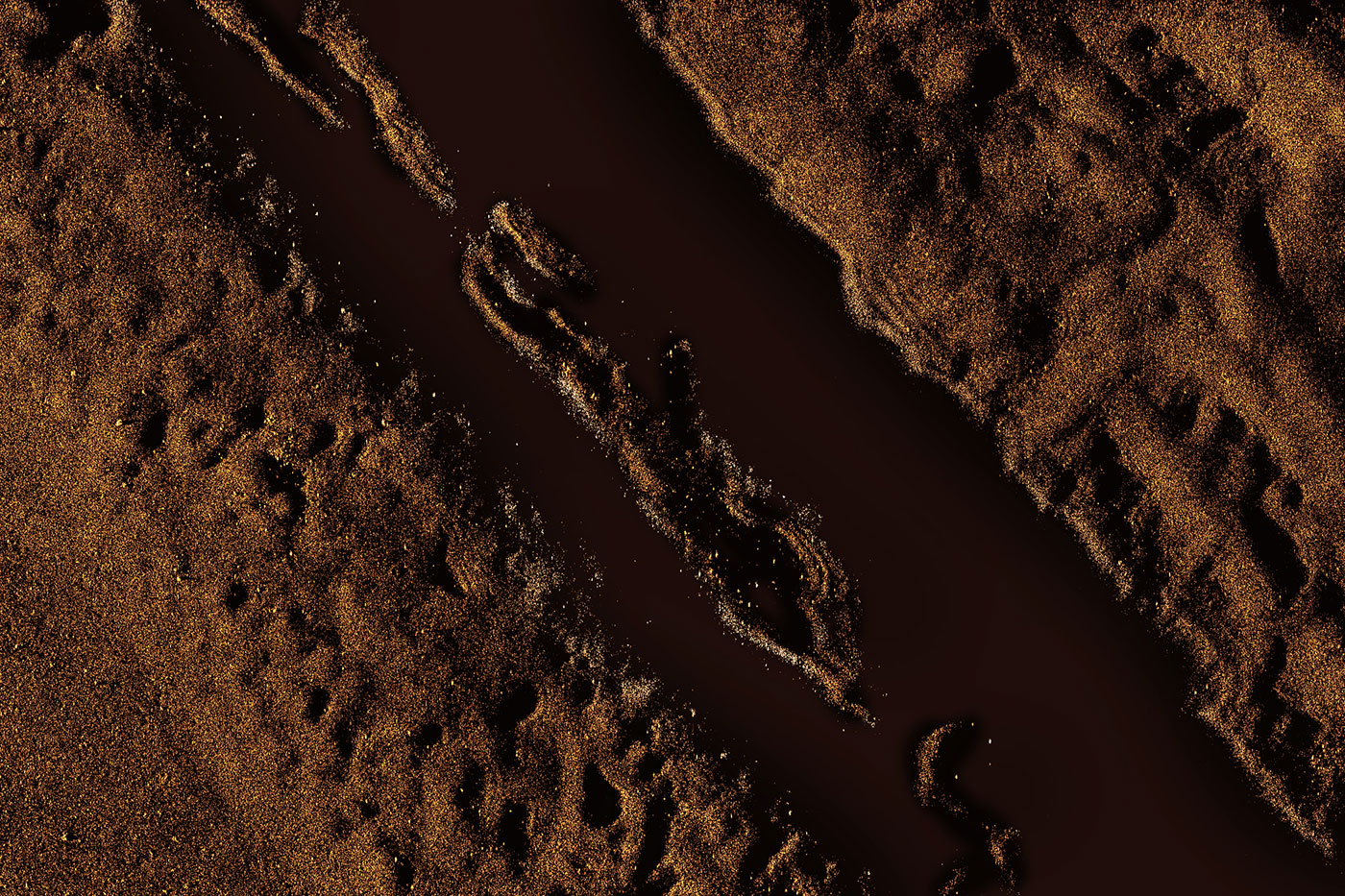Searching uncharted Arctic waters for Franklin’s lost ships
From Defence Research and Development Canada
March 16, 2015
When modern-day Canadian explorers made what has been described as the discovery of the century by finding one of Sir John Franklin’s lost ships, defence scientists were honoured to be part of the 2014 Victoria Strait Expedition.
Transcript
Autonomous vehicle braves unknown Arctic waters during 2014 Franklin expedition

“We were proud to be able to be a part of this historic event with Parks Canada and showcase our technology on behalf of Defence Research and Development Canada (DRDC) and the Department of National Defence (DND)”, said DRDC defence scientist Vincent Myers.
Numerous expeditions to find the lost Franklin ships have led to the mapping part of Canada’s Arctic, but no ships were ever found. In the end, clues from Inuit oral history, expedition reports on the possible route and final resting places of the Franklin ships, a better understanding of annual pack ice movements, modern sonar technology, and a bit of luck led the Canadian team to successfully discover Her Majesty’s Ship (HMS) Erebus.
Led by Parks Canada, the 2014 Victoria Strait Expedition included several Government of Canada departments and private organizations including the Royal Canadian Geographical Society (RCGS).
In support of the Royal Canadian Navy (RCN), six DRDC scientists and two RCN personnel travelled to the Victoria Strait with the Arctic Explorer, a state-of-the-art autonomous underwater vehicle (AUV), to survey the seabed in search of the lost Franklin expedition ships. The Explorer team contributed to reducing the search area for the remaining lost ship HMS Terror.
During the 2014 Victoria Strait Expedition, the DRDC research team seized the opportunity to test the unique capabilities of the Arctic Explorer AUV in a previously uncharted area of the Arctic Ocean seabed under harsh conditions of extreme cold, constantly moving ice floes, and rapidly changing weather patterns.
“We were proud to be able to be a part of this historic event with Parks Canada and showcase our technology on behalf of Defence Research and Development Canada (DRDC) and the Department of National Defence (DND)”, said DRDC defence scientist Vincent Myers.
Numerous expeditions to find the lost Franklin ships have led to the mapping part of Canada’s Arctic, but no ships were ever found. In the end, clues from Inuit oral history, expedition reports on the possible route and final resting places of the Franklin ships, a better understanding of annual pack ice movements, modern sonar technology, and a bit of luck led the Canadian team to successfully discover Her Majesty’s Ship (HMS) Erebus.
Led by Parks Canada, the 2014 Victoria Strait Expedition included several Government of Canada departments and private organizations including the Royal Canadian Geographical Society (RCGS).
In support of the Royal Canadian Navy (RCN), six DRDC scientists and two RCN personnel travelled to the Victoria Strait with the Arctic Explorer, a state-of-the-art autonomous underwater vehicle (AUV), to survey the seabed in search of the lost Franklin expedition ships. The Explorer team contributed to reducing the search area for the remaining lost ship HMS Terror.
During the 2014 Victoria Strait Expedition, the DRDC research team seized the opportunity to test the unique capabilities of the Arctic Explorer AUV in a previously uncharted area of the Arctic Ocean seabed under harsh conditions of extreme cold, constantly moving ice floes, and rapidly changing weather patterns.
“We were proud to be able to be a part of this historic event with Parks Canada and showcase our technology on behalf of Defence Research and Development Canada (DRDC) and the Department of National Defence (DND)”, said DRDC defence scientist Vincent Myers.
Numerous expeditions to find the lost Franklin ships have led to the mapping part of Canada’s Arctic, but no ships were ever found. In the end, clues from Inuit oral history, expedition reports on the possible route and final resting places of the Franklin ships, a better understanding of annual pack ice movements, modern sonar technology, and a bit of luck led the Canadian team to successfully discover Her Majesty’s Ship (HMS) Erebus.
Led by Parks Canada, the 2014 Victoria Strait Expedition included several Government of Canada departments and private organizations including the Royal Canadian Geographical Society (RCGS).
In support of the Royal Canadian Navy (RCN), six DRDC scientists and two RCN personnel travelled to the Victoria Strait with the Arctic Explorer, a state-of-the-art autonomous underwater vehicle (AUV), to survey the seabed in search of the lost Franklin expedition ships. The Explorer team contributed to reducing the search area for the remaining lost ship HMS Terror.
During the 2014 Victoria Strait Expedition, the DRDC research team seized the opportunity to test the unique capabilities of the Arctic Explorer AUV in a previously uncharted area of the Arctic Ocean seabed under harsh conditions of extreme cold, constantly moving ice floes, and rapidly changing weather patterns.
“It was an amazing experience to watch the DRDC team at work in Arctic conditions and see the unique capabilities of the Arctic Explorer in action.”
“It was an amazing experience to watch the DRDC team at work in Arctic conditions and see the unique capabilities of the Arctic Explorer in action,” says John Geiger, CEO of the Royal Canadian Geographical Society (RCGS). “This expedition not only showcased world-leading Canadian technology, and emphasized Canadian presence and capability in our Arctic, but it was an outstanding example of a successful collaboration between public, private and non-profit sector partners using advanced Canadian technology to make our mark in the history books.”
The Arctic Explorer was equipped with a high frequency AquaPix® Interferometric Synthetic Aperture Sonar (INSAS), manufactured by Kraken Sonar Systems Inc. of St. John’s Newfoundland and Labrador. At more than seven metres in length, the Arctic Explorer, manufactured by International Submarine Engineering Ltd of Port Coquitlam, British Columbia, makes an incredibly stable platform for the operation of this high- resolution sonar. The combination of these capabilities created an AUV system which produced high-resolution images of the seafloor over a much greater range than previous sonar systems.
“It was an amazing experience to watch the DRDC team at work in Arctic conditions and see the unique capabilities of the Arctic Explorer in action,” says John Geiger, CEO of the Royal Canadian Geographical Society (RCGS). “This expedition not only showcased world-leading Canadian technology, and emphasized Canadian presence and capability in our Arctic, but it was an outstanding example of a successful collaboration between public, private and non-profit sector partners using advanced Canadian technology to make our mark in the history books.”
The Arctic Explorer was equipped with a high frequency AquaPix® Interferometric Synthetic Aperture Sonar (INSAS), manufactured by Kraken Sonar Systems Inc. of St. John’s Newfoundland and Labrador. At more than seven metres in length, the Arctic Explorer, manufactured by International Submarine Engineering Ltd of Port Coquitlam, British Columbia, makes an incredibly stable platform for the operation of this high- resolution sonar. The combination of these capabilities created an AUV system which produced high-resolution images of the seafloor over a much greater range than previous sonar systems.
“The 2014 deployment of the Arctic Explorer in uncharted Arctic territory has given us the clearest, most exciting data collected and imagery attained in this part of the world to date.”
– Dale Reding, Director General Science and Technology Air Force and Navy, DRDC
“The 2014 deployment of the Arctic Explorer in uncharted Arctic territory has given us the clearest, most exciting data collected and imagery attained in this part of the world to date.”
– Dale Reding, Director General Science and Technology Air Force and Navy, DRDC
“The 2014 deployment of the Arctic Explorer in uncharted Arctic territory has given us the clearest, most exciting data collected and imagery attained in this part of the world to date.”
– Dale Reding, Director General Science and Technology Air Force and Navy, DRDC
“The 2014 deployment of the Arctic Explorer in uncharted Arctic territory has given us the clearest, most exciting data collected and imagery attained in this part of the world to date,” said Dale Reding, DRDC’s Director General Science and Technology Air Force and Navy.
During the expedition, the DRDC team witnessed yet again that the Arctic remains a very challenging domain. Heavy pack-ice, shallow waters and frequent storm systems make the summer navigation season very short, easily interrupted and difficult to operate in for an Arctic research team. Personnel with Arctic operating experience can be as much an ingredient for mission success as new technology.
In 2010 and 2011, Arctic Explorer AUVs successfully completed under-ice surveys in support of Canada’s United Nations Convention on the Law of the Sea submission. Key to the success of these survey missions was the development and use of a unique underwater acoustic homing system, developed by Omnitech Inc. of Dartmouth, Nova Scotia. This technology enabled the AUV to find its way home to a drifting ice-camp or ship from distances of over 50 km.
“It set a new world record for under-ice operations in the Western Arctic, autonomously travelling 1,000 kilometres underwater over ten continuous days,” said Dale Reding. “The exploration work done on behalf of the expedition is an important step in advancing science and research in the Arctic environment and directly supports Government of Canada priorities. ”
During the 2014 Expedition, DRDC undertook several experiments to assess and understand the impact that low water temperatures have on the performance of various types of imaging sonars. Data from the experiments will be used to validate existing sonar models and provide information to the RCN regarding decisions about future sonar acquisitions.
“DRDC has a long history of exceptional partnership with the Royal Canadian Navy, and the deployment of Arctic Explorer and agency personnel with northern operating experience were important elements of the successful 2014 Victoria Strait search,” said Rear Admiral John Newton, Commander of Maritime Forces Atlantic and Joint Task Force Atlantic. “Pushing advanced technologies into northern waters was a clear demonstration of Canadian ambition and sovereignty, and a vital learning opportunity as the navy prepares to receive purpose built Arctic patrol ships.”
If the Government of Canada or the RCN decide to undertake further exploration of the Arctic, the DRDC AUVs and research team offer a highly specialized and unique capability to support those efforts.
The 2014 Victoria Strait Expedition was a public-private partnership led by Parks Canada and included the RCN, the Canadian Coast Guard, DRDC, the Royal Canadian Geographic Society, One Ocean Expeditions, the Arctic Research Foundation, The W. Garfield Weston Foundation, Shell Canada, and the Government of Nunavut.
DRDC will continue to support the Government of Canada’s Northern Strategy and to refine AUV technology and capabilities. The Agency has operated in the Arctic since the early 1950s, when scientists established research camps and programs and made discoveries that underlie our current understanding of glaciers and ice movement, navigation and Arctic clothing.


